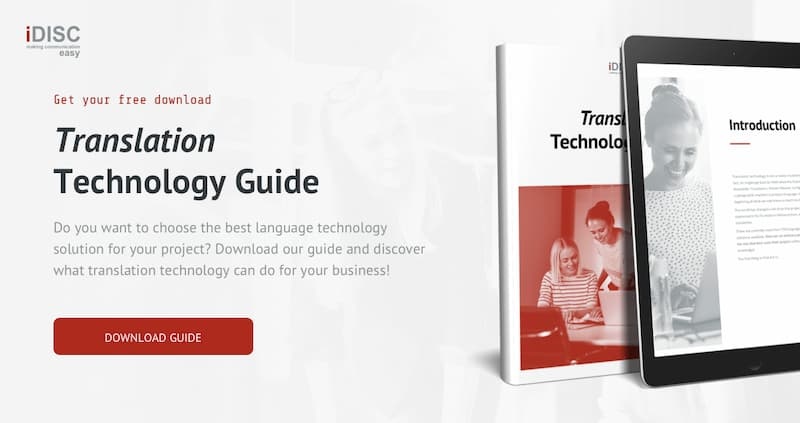The world of translation has been and is in a constant state of evolution, especially over the last decade. Today, it’s a vital service for most businesses, which are obliged to adapt to changes in technology in order to stay ahead: internet, software, communication tools, the phenomenon of globalization, etc.
Since its beginning, technology has been closely linked to the translation process, as it has been for many other activities essential for the development of our society and which, over the years, have been increasingly perfected.
By translation technology we mean all software tools that optimize and streamline the process of converting written text from one language to another.
Currently, we can find over 700 technological solutions on the market designed to assist with the translation process. However, not all are suitable for the same tasks.
When content needs to be translated or adapted into another language, the choice of one tool or another will depend on the nature of the text and the purpose of the translation.
Therefore, in this article, we will go over the maintranslation technology tools and the features of each one, so that you can decide which one best suits your needs and the needs of your project.
Take note!
CAT Tools
CAT tools are translation tools that use software created to assist translators in converting text from one language to another, making this process faster and more efficient. Their main aim is to simplify repetitive query-based tasks so that the translator can focus their undivided attention on the key aspects of the text itself.
These tools allow all the information and elements the linguist needs to carry out their work, such as glossaries or reference materials, to be integrated into a single environment, streamlining the process and facilitating search tasks and research.
Features of CAT tools
CAT tools make the translator’s job much easier.
Some of their most beneficial features are:
Segmented text
They help the translator read and understand the original text by segmenting it into translation units. In other words, phrases in the source language units appear side-by-side with those in the target language. This view helps with the proofreading process.
Translation memories
These tools use Translation Memories (TM). These are bilingual corpora that continuously save translations so they can be used in future projects. This means a sort of library or database is created for each language pair, allowing translators to find segments that they have previously translated and reuse them in the new project.
Autocomplete
CAT tools, together with translation memories, offer the ability to autocomplete segments. In this case, the software automatically suggests segments that are already included in the translation memory. Segment suggestions depend on the concordance with the new source text, which can be exact (exact match) or partial (fuzzy match).
Glossaries
Specialized glossaries are also used. These glossaries can be updated as needed for the project at hand. For certain disciplines or very specific subjects, the role of glossaries is fundamental, as it allows translators to easily find highly technical terms within the subject area.
Additional resources
CAT tools include additional resources to help with the task at hand, such as buttons to access specific information about the text, images, links to external dictionaries, complementary reference material, etc.
Quality assurance
The QA check is an automated process that detects errors such as untranslated elements, inconsistent terminology, or issues with formatting tags. This feature is incredibly useful at saving time during the proofreading process.
Integration of CAT tools with other translation technologies
As we mentioned, the translation sector is making leaps and bounds on a daily basis. CAT tools have come a long way over the past few decades and have reached a point where they can be integrated with other translation technologies, such as machine translation engines, which are now a reality and undoubtedly also on the horizon for the future of translation technology.
Translation management systems (TMS)
Translation management systems are software-based platforms designed to streamline the management process for translation projects on a large scale. They work on the basis of creating workflows that stem from the starting point to the end of the project, reducing and optimizing human intervention with a clear objective: streamlining and standardizing processes. They help the project manager plan, assign tasks and manage projects in a more organized way.
Advantages of using a TMS
As we said, using a TMS facilitates, streamlines and optimizes project management processes. Each TMS offers different solutions depending on the business’s characteristics. However, the following are generally the features incorporated into a TMS that are most highly valued by most companies because of their many advantages:
- Multilingual platform.
- General dashboard where the project status can be monitored.
- Role assignments for each step.
- Option to import content and export it once translated.
- Integrated CAT tool features.
- Ability to integrate machine translation.
Integrations of main translation technology tools
Integrating all of these tools would not be possible without connectors, also known as application programming interfaces (APIs). These facilitate connectivity between existing systems and new tools belonging to content management systems (CMSs).
Ultimately, this is an all-in-one technology which integrates everything and allows for communication between different translation tools and connection with content platforms.
Machine translation (MT) tools
MT tools are software based on an automated translation system that requires no human intervention. The difference between these and CAT tools is that this system can produce a translation on its own, without the involvement of a human translator. There are three types of machine translation systems:
Rule-Based Machine Translation (RBMT)
Rule-based machine translation is a mechanism that translates words and phrases based on a series of previously established rules.
Currently, among the most widely used translation technologies, RBMT arouses much less interest, since it needs to have the grammar systems of the source and target languages, bilingual dictionaries, and transfer rules between languages, which implies a greater investment of time and resources.
Statistical Machine Translation (SMT)
Statistical machine translation is a system that translates based on an analysis of previously imported bilingual corpora.
This machine translation model consists of three core components:
- The language model: responsible for the fluidity of the translation and checking the likelihood that the translation is correct in the target language based on a monolingual corpus.
- The translation model: establishes concordance between the source language and the target language. During translation engine training, this model is in charge of constructing a sentence-level concordance corpus between the two languages.
- The decoder model: searches the multiple possible translations to find the most probable for each specific case, based on the above language and translation models.
Neural Machine Translation (NMT)
Neural Machine Translation is a system that translates based on prior learning and is capable of predicting future text. These systems work using artificial intelligence and are capable of emulating the process of translating complete phrases and even paragraphs.
While the introduction of machine translation has been a revolutionary and innovative change for the sector, a machine translation tool that requires zero human intervention has yet to be developed. Currently, the proofreading, correction, improvement and perfection of machine-translated text, known as postediting, is essential in the majority of cases.
As we said before, depending on the type of text to be translated and the desired result, AI translation may not be enough. When dealing with press releases, marketing campaigns, complete product descriptions or even updating internal information, a level of sensitivity is needed that, at the moment, only a human translator can provide.
Given the choice of language service providers currently on the market, we believe that the key is in choosing a translation agency that masters translation technology, has experience in your sector and can guarantee on-time delivery.
We hope you’ve enjoyed this article. If you’d like to know more about this topic, we recommend you visit our blog or get in touch for further information.





